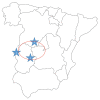Fatal Case of Crimean-Congo Hemorrhagic Fever Caused by Reassortant Virus, Spain, 2018
- PMID: 33754998
- PMCID: PMC8007309
- DOI: 10.3201/eid2704.203462
Fatal Case of Crimean-Congo Hemorrhagic Fever Caused by Reassortant Virus, Spain, 2018
Abstract
In August 2018, a fatal autochthonous case of Crimean-Congo hemorrhagic fever was confirmed in western Spain. The complete sequence of the viral genome revealed circulation of a new virus because the genotype differs from that of the virus responsible for another case in 2016. Practitioners should be alert to possible new cases.
Keywords: Crimean Congo hemorrhagic fever virus; Hyalomma; RT-PCR; Spain; molecular epidemiology; phylogenetic analyses; reassortant; tick-borne illness; ticks; vector-borne infections; viruses; zoonoses.
Figures


Similar articles
-
Crimean-Congo Hemorrhagic Fever, Spain, 2013-2021.Emerg Infect Dis. 2023 Feb;29(2):252-259. doi: 10.3201/eid2902.220677. Emerg Infect Dis. 2023. PMID: 36692301 Free PMC article. Review.
-
Phylogenetic Characterization of Crimean-Congo Hemorrhagic Fever Virus, Spain.Emerg Infect Dis. 2017 Dec;23(12):2078-2080. doi: 10.3201/eid2312.171002. Emerg Infect Dis. 2017. PMID: 29148370 Free PMC article.
-
Survey of Crimean-Congo Hemorrhagic Fever Enzootic Focus, Spain, 2011-2015.Emerg Infect Dis. 2019 Jun;25(6):1177-1184. doi: 10.3201/eid2506.180877. Emerg Infect Dis. 2019. PMID: 31107219 Free PMC article.
-
Genomic Characterization of Crimean-Congo Hemorrhagic Fever Virus in Hyalomma Tick from Spain, 2014.Vector Borne Zoonotic Dis. 2017 Oct;17(10):714-719. doi: 10.1089/vbz.2017.2190. Epub 2017 Aug 24. Vector Borne Zoonotic Dis. 2017. PMID: 28836897 Free PMC article.
-
Crimean-Congo hemorrhagic fever: history, epidemiology, pathogenesis, clinical syndrome and genetic diversity.Antiviral Res. 2013 Oct;100(1):159-89. doi: 10.1016/j.antiviral.2013.07.006. Epub 2013 Jul 29. Antiviral Res. 2013. PMID: 23906741 Review.
Cited by
-
The Biological and Ecological Features of Northbound Migratory Birds, Ticks, and Tick-Borne Microorganisms in the African-Western Palearctic.Microorganisms. 2023 Jan 7;11(1):158. doi: 10.3390/microorganisms11010158. Microorganisms. 2023. PMID: 36677450 Free PMC article. Review.
-
Widespread Detection of Multiple Strains of Crimean-Congo Hemorrhagic Fever Virus in Ticks, Spain.Emerg Infect Dis. 2021 Feb;28(2):394-402. doi: 10.3201/eid2802.211308. Emerg Infect Dis. 2021. PMID: 35076008 Free PMC article.
-
Crimean-Congo Hemorrhagic Fever, Spain, 2013-2021.Emerg Infect Dis. 2023 Feb;29(2):252-259. doi: 10.3201/eid2902.220677. Emerg Infect Dis. 2023. PMID: 36692301 Free PMC article. Review.
-
Detection of novel orthoparamyxoviruses, orthonairoviruses and an orthohepevirus in European white-toothed shrews.Microb Genom. 2024 Aug;10(8):001275. doi: 10.1099/mgen.0.001275. Microb Genom. 2024. PMID: 39088249 Free PMC article.
-
Empirical treatment with doxycycline of fever of intermediate duration.Eur J Clin Microbiol Infect Dis. 2021 Sep;40(9):2047-2050. doi: 10.1007/s10096-021-04322-2. Epub 2021 Jul 30. Eur J Clin Microbiol Infect Dis. 2021. PMID: 34327567 Free PMC article. No abstract available.
References
Publication types
MeSH terms
LinkOut - more resources
Full Text Sources
Other Literature Sources

